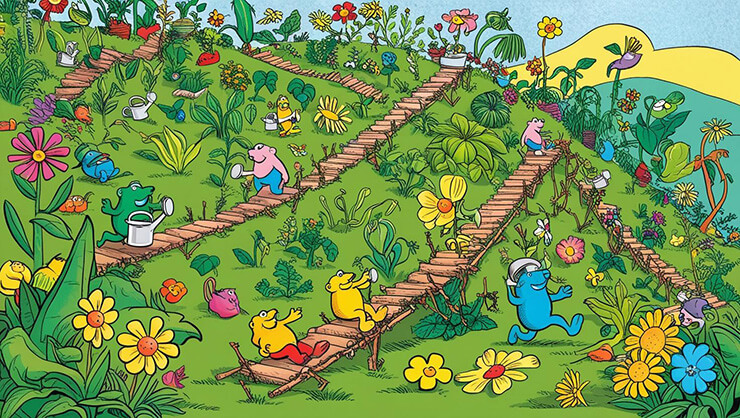Read by Michael Flamel

Living in Northern California means embracing the fluidity of seasons, where both people and plants learn to go with the flow. Growing up gardening in Massachusetts, I had no idea I’d later come to love the unpredictable nature of California’s weather. In Sonoma County, if Winter brings heavy rain, the garden bursts into life before Spring even arrives, painting the landscape in neon yellows. But in dry Winters, seeds and roots lie low, camouflaged by the gray hillsides, waiting for the right moment to emerge. And when they do, watch out!
Driving through our coastal county this Spring, I’ve seen old apple trees in hillside orchards losing limbs, unable to bear the weight of waterlogged wood. These resilient Gravenstein trees have weathered more droughts than rains in recent years. Meanwhile, black and valley oaks in the woodlands sit spongy and overwhelmed, wishing for dry spells to rest under their leafy blankets like sleepy teenagers.
This much rain brings gravity into sharp focus in our garden, perched on a foggy hillside about 10 miles inland from the Pacific Ocean. Monterey pines stand tall at the top, while redwoods, black oaks, bay, and wild hazelnut blanket the slopes below. All Winter, I watched landslides shape a new garden topography. Our long, winding brick steps became a glistening waterfall, complete with quivering clover and green slime. I even considered planting watercress in the newly formed streams—an idea that seemed absurd just a couple of years ago when drought loomed over us. This year, I gambled on a wet, boggy spot where rainwater spills over a wall, and now I have a stunning patch of spearmint thriving there. In drier years, mint struggled, but this Winter, a new lawn formed where gravel once lay, and a gopher hole transformed into a miniature geyser.
With the return of the sun, Spring has exploded in chartreuse and lavender. What were once neat lines of osteospermum have become drifts of purple across the hillsides. These flowers, which refused to grow in our old inland garden, now thrive here, spreading joy with their early Spring blooms. Euphorbias have popped up like neon aliens, their puffs glowing all over the garden. These hardy plants went up, down, and sideways, filling planters, nestling in roots, and squeezing into rock crevices. They’re almost bullies, pushing out tender plants like yarrow, but their resilience is admirable.
Fallen-rock walls, broken by rushing water, lie in masses of Santa Barbara daisies, which happily cover the mess with their tiny starry flowers. These delicate yet vigorous blooms remind me of nature’s tidy cleanup crew. Birds-of-paradise have also made a surprise appearance, their bright flowers emerging from hidden rhizomes, thanks to the plentiful rain. I’ve never had such luck growing these prized flowers before, and their arrival feels like a joyous gift.
This happy chaos makes me laugh as I watch the garden design itself. Water features appeared without any digging, resident rodents laid invisible irrigation pipes, and spontaneous bouquets filled gashes and holes. I saved on water, supplies, labor, and gas all year. The garden now resembles the board game Chutes and Ladders, with plants and paths squiggling in every direction. The oldest floral residents shift around, trying out warmer or wetter spots, sending their offspring and cousins up ladders and down chutes, securing their place in the Summer sun. ❖
About the Author: Amanda Niamh Dawson lives with her husband, two kids, two dogs, and three adopted gopher-eating cats in western Sonoma County, California. In this blessed banana belt, where citrus and peaches grow, Amanda’s passion for gardening often competes with her love of writing. When she’s in the garden, she feels she should be writing about it, and when she’s writing, she longs to get back to her plants.


 Previous
Previous

